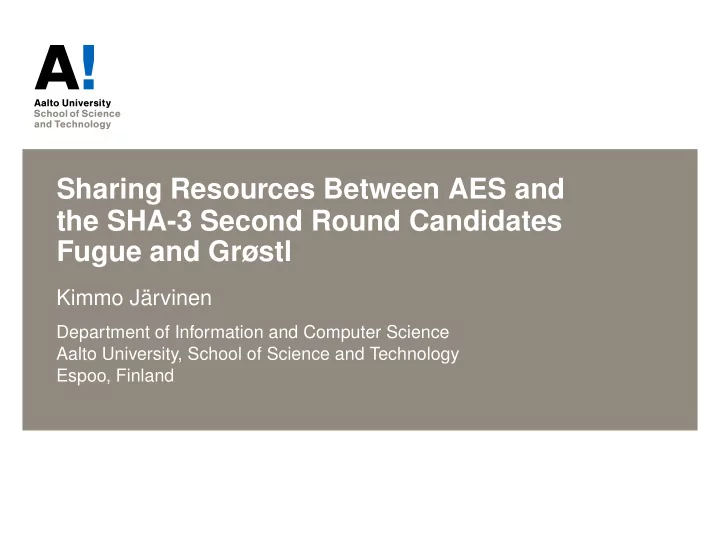

Sharing Resources Between AES and the SHA-3 Second Round Candidates Fugue and Grøstl Kimmo Järvinen Department of Information and Computer Science Aalto University, School of Science and Technology Espoo, Finland
AES-inspired SHA-3 Candidates ◮ Design strongly influenced by AES: Share the structure and have significant similarity in transformations, or even use AES as a subroutine ◮ ECHO, Fugue, Grøstl, and SHAvite-3 ◮ Benadjila et al. (ASIACRYPT 2009) studied useability of Intel’s AES instructions for AES-inspired candidates Conclusion: only ECHO and SHAvite-3, which use AES as a subroutine, benefit from the instructions ◮ This is the first study of combining AES with the SHA-3 candidates on hardware (FPGA) The 2nd SHA-3 Candidate Conference Santa Barbara, CA, USA August 23–24, 2010
Research Topics and Motivation Research Questions ◮ What modifications are required to embed AES into the data path of the hash algorithm (or vice versa)? ◮ How much resources can be shared (logic, registers, memory, . . . )? ◮ What are the costs (area, delay, throughput, power consumption, . . . )? Applications ◮ Any applications that require dedicated hardware implementations of a hash algorithm and a block cipher would benefit from reduced costs ◮ Particularly important if resources are very limited The 2nd SHA-3 Candidate Conference Santa Barbara, CA, USA August 23–24, 2010
Advanced Encryption Standard AES with a 128-bit key (AES-128) ◮ State: 4 × 4 bytes; each byte is an element of GF ( 2 8 ) ◮ 10 rounds with four transformations Transformations ◮ SubBytes: Bytes mapped independently with (1) a multiplicative inverse in GF ( 2 8 ) and (2) an affine transformation ◮ ShiftRows: The row i shifted to the left by i bytes ◮ MixColumns: Columns multiplied with a fixed polynomial over GF ( 2 8 ) modulo x 4 + 1 (omitted in the last round) ◮ AddRoundKey: A 128-bit bitwise xor with a round key The 2nd SHA-3 Candidate Conference Santa Barbara, CA, USA August 23–24, 2010
Fugue ◮ 32-bit block size, 960-bit chaining value ◮ AES-inspired SMIX and certain other transformations (xors and rotations) ◮ SMIX operates on 128 bits ◮ SMIX includes SubBytes of AES followed by Super-Mix inspired by MixColumns ◮ Super-Mix includes cross-mixing between columns and can be seen as a matrix multiplication where a 16-byte vector is multiplied from the left by a 16 × 16 byte matrix (sparse) The 2nd SHA-3 Candidate Conference Santa Barbara, CA, USA August 23–24, 2010
Fugue / AES ◮ SubBytes shared entirely ◮ ShiftRows embedded into the input multiplexers ◮ Super-Mix/MixColumns share the multipliers and xors but require additional multiplexers ◮ Interface mismatch (inputs 32 vs. 128 bits, outputs 256 vs. 128 bits) ◮ KeyExpansion on the data path can share four S-boxes and reuse registers ( h ) but doubles the latency The 2nd SHA-3 Candidate Conference Santa Barbara, CA, USA August 23–24, 2010
Grøstl ◮ 512-bit block size, 512-bit chaining value ◮ The compression function consists of two AES-inspired transformations: P and Q which are almost the same ◮ P and Q include AddRoundConstant (the only difference between P and Q ), SubBytes, ShiftBytes, and MixBytes ◮ The transformations are applied to a 512-bit State The 2nd SHA-3 Candidate Conference Santa Barbara, CA, USA August 23–24, 2010
Grøstl / AES ◮ The 512-bit Grøstl data path used for at most four parallel AES encryptions (or KeyExpansions) ◮ SubBytes shared entirely ◮ ShiftRows constructed from ShiftBytes by swapping some bytes (12 if four parallel AES encryptions) ◮ MixBytes/MixColumns share the multipliers and xors but require additional multiplexers The 2nd SHA-3 Candidate Conference Santa Barbara, CA, USA August 23–24, 2010
Results Table: Fugue results on Altera Cyclone III EP3C80F780C7 FPGA fugue fugue_aes fugue_aes_ke Place&route results Logic cells (LC) 3562 4520 ( + 26 . 9 %) 4875 ( + 36 . 9 %) Registers 1005 1105 ( + 10 . 0 %) 1113 ( + 10 . 7 %) f max (MHz) 63.93 60.75 ( − 5 . 0 %) 59.81 ( − 6 . 4 %) Fugue performance Latency (clock cyc.) 2 2 2 Throughput (Gbps) 1.023 0.972 0.957 AES performance Latency (clock cyc.) – 10 20 Throughput (Gbps) – 0.778 0.383 Note: AES core with KeyExpansion requires 2525 LCs and 527 registers (of which KeyExpansion takes 536 LCs and 136 regs.) The 2nd SHA-3 Candidate Conference Santa Barbara, CA, USA August 23–24, 2010
Results (cont.) Table: Grøstl results on Altera Cyclone III EP3C80F780C7 FPGA groestl groestl_aes groestl_aes_ke groestl_4aes Place&route results Logic cells (LC) 12086 12387 ( + 2 . 5 %) 12520 ( + 3 . 6 %) 13723 ( + 13 . 5 %) Registers 1547 1550 ( + 0 . 2 %) 1558 ( + 0 . 7 %) 1550 ( + 0 . 2 %) f max (MHz) 57.52 54.13 ( − 5 . 9 %) 55.79 ( − 3 . 0 %) 56.03 ( − 2 . 6 %) Grøstl performance Latency (clock cyc.) 20 20 20 20 Throughput (Gbps) 1.473 1.386 1.428 1.434 AES performance Latency (clock cyc.) – 10 10 10 Throughput (Gbps) – 0.693 0.714 2.869 The 2nd SHA-3 Candidate Conference Santa Barbara, CA, USA August 23–24, 2010
Conclusions ◮ Both Fugue and Grøstl can be combined with AES with small overheads in area and speed (at least in FPGAs) ◮ Grøstl has almost negligible overheads because the entire data path and registers can be shared in a direct manner and including parallel encryptions and KeyExpansion(s) is easy ◮ Possibility to efficiently combine the hash algorithm with AES is an asset that should be taken into account while selecting SHA-3 ◮ Future work: Other data path widths, unrolling and pipelining, different algorithm variants, side-channel countermeasures, . . . The 2nd SHA-3 Candidate Conference Santa Barbara, CA, USA August 23–24, 2010
Thank you. Questions? The 2nd SHA-3 Candidate Conference Santa Barbara, CA, USA August 23–24, 2010
Recommend
More recommend